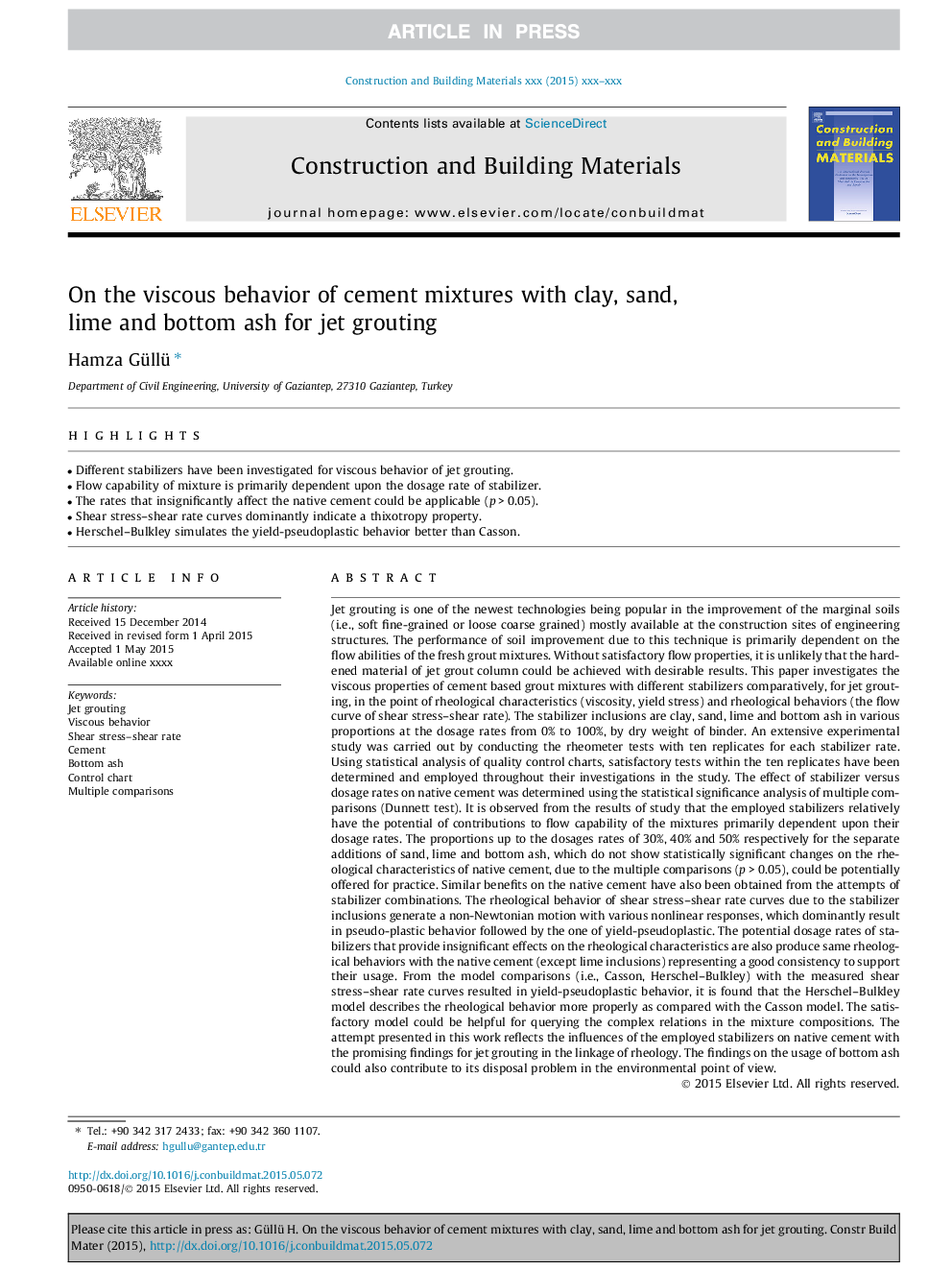| کد مقاله | کد نشریه | سال انتشار | مقاله انگلیسی | نسخه تمام متن |
|---|---|---|---|---|
| 6720732 | 503559 | 2015 | 20 صفحه PDF | دانلود رایگان |
عنوان انگلیسی مقاله ISI
On the viscous behavior of cement mixtures with clay, sand, lime and bottom ash for jet grouting
ترجمه فارسی عنوان
در رفتار چسبندگی مخلوط سیمان با خاک رس، شن و ماسه، آهک و خاکستر برای تزریق جت
دانلود مقاله + سفارش ترجمه
دانلود مقاله ISI انگلیسی
رایگان برای ایرانیان
کلمات کلیدی
تزریق جت، رفتار ویسکوز، تنش برشی، سرعت برش، سیمان، خاکستر پایین نمودار کنترلی، مقایسه چندگانه،
موضوعات مرتبط
مهندسی و علوم پایه
سایر رشته های مهندسی
مهندسی عمران و سازه
چکیده انگلیسی
Jet grouting is one of the newest technologies being popular in the improvement of the marginal soils (i.e., soft fine-grained or loose coarse grained) mostly available at the construction sites of engineering structures. The performance of soil improvement due to this technique is primarily dependent on the flow abilities of the fresh grout mixtures. Without satisfactory flow properties, it is unlikely that the hardened material of jet grout column could be achieved with desirable results. This paper investigates the viscous properties of cement based grout mixtures with different stabilizers comparatively, for jet grouting, in the point of rheological characteristics (viscosity, yield stress) and rheological behaviors (the flow curve of shear stress-shear rate). The stabilizer inclusions are clay, sand, lime and bottom ash in various proportions at the dosage rates from 0% to 100%, by dry weight of binder. An extensive experimental study was carried out by conducting the rheometer tests with ten replicates for each stabilizer rate. Using statistical analysis of quality control charts, satisfactory tests within the ten replicates have been determined and employed throughout their investigations in the study. The effect of stabilizer versus dosage rates on native cement was determined using the statistical significance analysis of multiple comparisons (Dunnett test). It is observed from the results of study that the employed stabilizers relatively have the potential of contributions to flow capability of the mixtures primarily dependent upon their dosage rates. The proportions up to the dosages rates of 30%, 40% and 50% respectively for the separate additions of sand, lime and bottom ash, which do not show statistically significant changes on the rheological characteristics of native cement, due to the multiple comparisons (p > 0.05), could be potentially offered for practice. Similar benefits on the native cement have also been obtained from the attempts of stabilizer combinations. The rheological behavior of shear stress-shear rate curves due to the stabilizer inclusions generate a non-Newtonian motion with various nonlinear responses, which dominantly result in pseudo-plastic behavior followed by the one of yield-pseudoplastic. The potential dosage rates of stabilizers that provide insignificant effects on the rheological characteristics are also produce same rheological behaviors with the native cement (except lime inclusions) representing a good consistency to support their usage. From the model comparisons (i.e., Casson, Herschel-Bulkley) with the measured shear stress-shear rate curves resulted in yield-pseudoplastic behavior, it is found that the Herschel-Bulkley model describes the rheological behavior more properly as compared with the Casson model. The satisfactory model could be helpful for querying the complex relations in the mixture compositions. The attempt presented in this work reflects the influences of the employed stabilizers on native cement with the promising findings for jet grouting in the linkage of rheology. The findings on the usage of bottom ash could also contribute to its disposal problem in the environmental point of view.
ناشر
Database: Elsevier - ScienceDirect (ساینس دایرکت)
Journal: Construction and Building Materials - Volume 93, 15 September 2015, Pages 891-910
Journal: Construction and Building Materials - Volume 93, 15 September 2015, Pages 891-910
نویسندگان
Hamza Güllü,
